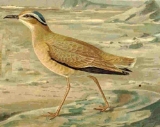
Courser
Encyclopedia
The Coursers are a group of bird
s which together with the pratincole
s make up the family Glareolidae. They have long legs, short wings and long pointed bills which curve downwards. Their most unusual feature for birds classed as wader
s is that they inhabit deserts and similar arid regions.
They have cryptic plumage and crouch down when alarmed to avoid detection by predators.
Like the pratincoles, the coursers are found in warmer parts of the Old World
. They hunt insects by running.
Their 2-3 eggs are laid on the ground.
Bird
Birds are feathered, winged, bipedal, endothermic , egg-laying, vertebrate animals. Around 10,000 living species and 188 families makes them the most speciose class of tetrapod vertebrates. They inhabit ecosystems across the globe, from the Arctic to the Antarctic. Extant birds range in size from...
s which together with the pratincole
Pratincole
The Pratincoles or Greywaders are a group of birds which together with the coursers and Egyptian Plover make up the family Glareolidae. They have short legs, very long pointed wings and long forked tails....
s make up the family Glareolidae. They have long legs, short wings and long pointed bills which curve downwards. Their most unusual feature for birds classed as wader
Wader
Waders, called shorebirds in North America , are members of the order Charadriiformes, excluding the more marine web-footed seabird groups. The latter are the skuas , gulls , terns , skimmers , and auks...
s is that they inhabit deserts and similar arid regions.
They have cryptic plumage and crouch down when alarmed to avoid detection by predators.
Like the pratincoles, the coursers are found in warmer parts of the Old World
Old World
The Old World consists of those parts of the world known to classical antiquity and the European Middle Ages. It is used in the context of, and contrast with, the "New World" ....
. They hunt insects by running.
Their 2-3 eggs are laid on the ground.
Species in taxonomic order
- Egyptian PloverEgyptian PloverThe Egyptian Plover is a wader, the only member of the genus Pluvianus. Formerly placed in the pratincole and courser family, Glareolidae, it is now regarded as the sole member of its own monotypic family Pluvianidae....
Pluvianus aegyptius
- Cream-coloured CourserCream-coloured CourserThe Cream-colored Courser, Cursorius cursor, is a wader in the pratincole and courser family, Glareolidae.Although classed as waders, these are birds of dry open country, preferably semi-desert, where they typically hunt their insect prey by running on the ground.These coursers are found in...
Cursorius cursor - Temminck's CourserTemminck's CourserTemminck's Courser, Cursorius temminckii, is a bird in the pratincole and courser family, Glareolidae. It is a wader which lives in sub-Saharan Africa....
Cursorius temminckii - Indian CourserIndian CourserThe Indian Courser is a species of courser found in mainland South Asia, mainly in the plains bounded by the Ganges and Indus river system...
Cursorius coromandelius - Burchell's CourserBurchell's CourserThe Burchell's Courser Cursorius rufus is a wader in the pratincole and courser family, Glareolidae.Although classed as waders, these are birds of dry open country, preferably semi-desert, where they typically hunt their insect prey by running on the ground.This is a small bird that lives in the...
Cursorius rufus
- Two-banded Courser Rhinoptilus africanus
- Heuglin's Courser Rhinoptilus cinctus
- Violet-tipped Courser or Bronze-winged courser, Rhinoptilus chalcopterus
- Jerdon's CourserJerdon's CourserThe Jerdon's Courser is a nocturnal bird belonging to the pratincole and courser family Glareolidae endemic to India. The bird was discovered by the surgeon-naturalist Thomas C. Jerdon in 1848 but not seen again until its rediscovery in 1986. This courser is a restricted-range endemic found...
Rhinoptilus bitorquatus

